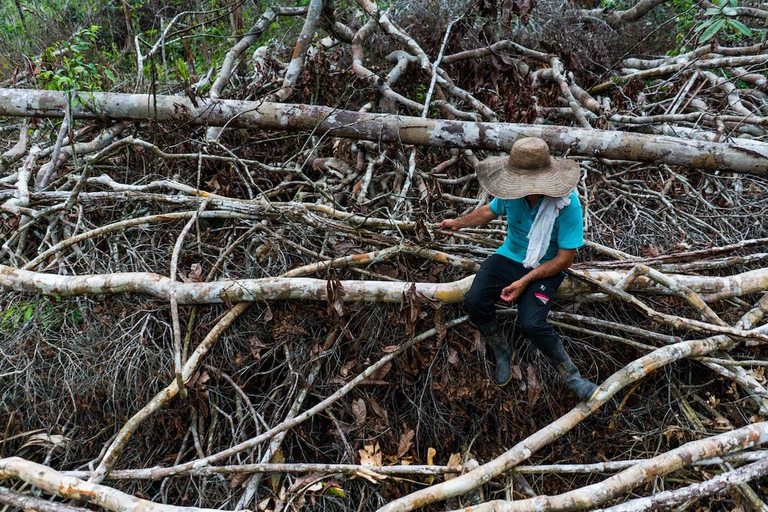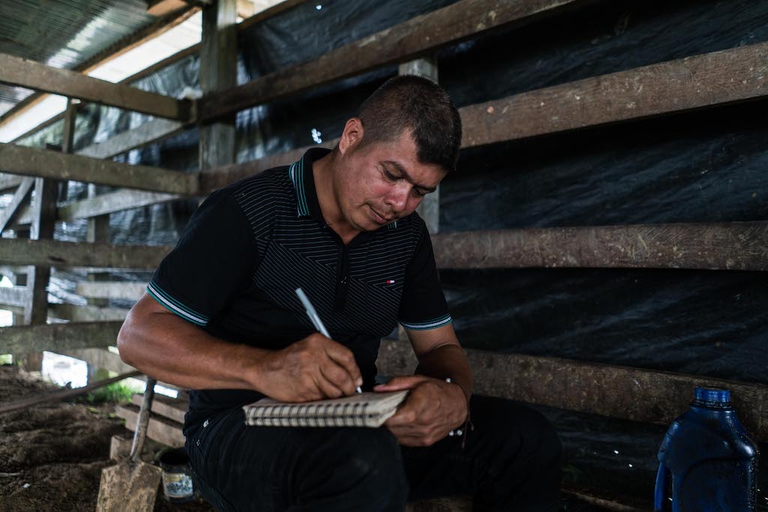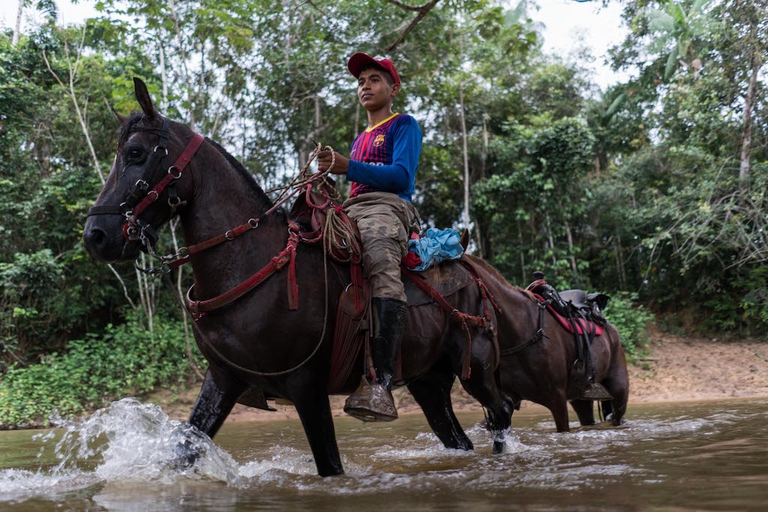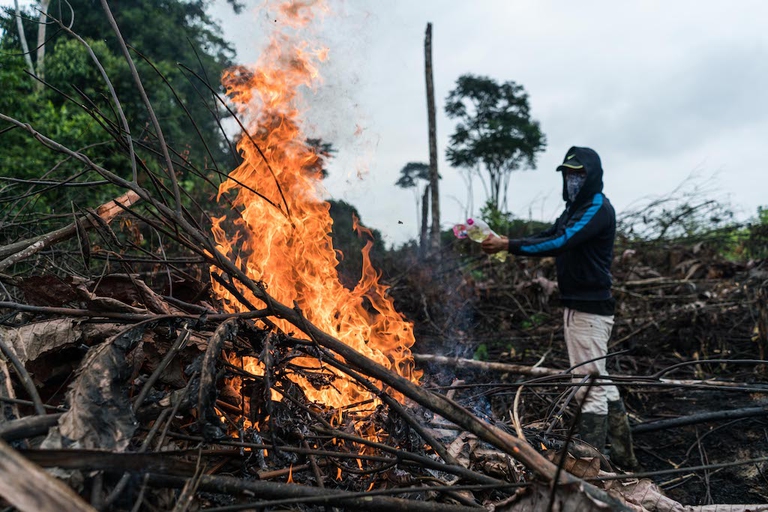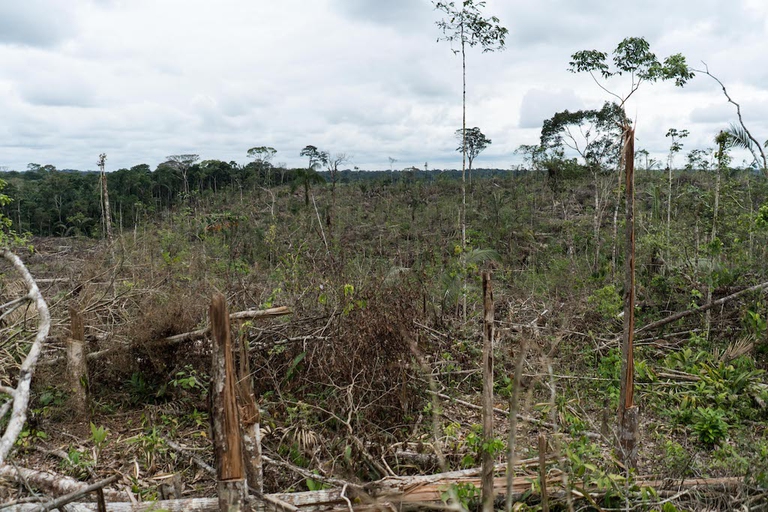
The Amazon became an alternative classroom during the pandemic. Now, the educational forest in Batraja, Bolivia, lives on to teach children and adults the value of nature.
Areas where the FARC guerrilla used to hold power in Colombia have faced record deforestation. Farmers cut down trees, burn land and plant grass for cows. Because, “what else can we do for a living here in the Colombian Amazon”? An intimate report from the heart of the felled forest in Caquetá.
Tumbas. In the Colombian part of the Amazon, this is the name given to huge areas where all the trees have been felled and where land is subsequently burned. Tumbas also means tombs.
Cemeteries in the Amazon.
I find myself in the middle of such a tomb with Jairo (46), known by his nickname Peluche. Teddybear. He’s smiley, jovial and has a similar effect to that of a funny teddybear. Peluche stands on top of a huge trunk, looking out over the tumba, the result of his hard work. He’s proud of this huge area he’s cleared in the jungle: 100 hectares. He’s preparing to burn it to then sow grass. 100 heads of cattle will graze here, it’s part of his legacy to his sons. The trunk Peluche is standing on used to be a tree, hundreds of years old.
Usually, as a journalist I try to be neutral, “objective”, as they say. I typically try not to ask leading questions.
But here in the midst of the destruction, I’m overcome with sadness. I feel as if I’m standing with a killer who proudly shows me his victims. The trees, the jungle, the lungs of the world. He stands on the corpse of one of the ancient trees, like a hunter with his trophy.
I can’t hold back. “How do you feel about having cut down all this forest? Don’t you feel bad about it?” I almost attack him with my words.
Peluche disappears into himself. We walked for an hour under the burning sun to get here, chatting pleasantly, laughing. It’s almost as if it were his life’s work he’s showing me.
My question touches something deep inside him.
“To me, we’re on our way to the end of the world. Those trees are like my children. The plants, the water, the forest are the most sacred things. It gives me a moral hangover to cut down the forest, but what else can I do? What else can I do for a living?” Peluche pronounces his words, which dissipate into the air. Even the sounds – or the absence of sounds – in this deforested area are different. The birds and insects who normally deafen you with their noises are no longer here. It’s the funeral vigil of the jungle.
Colombia is the second country in the world with the most tree biodiversity (after Brazil), with 5,776 registered species. Since the government signed the peace accords with the former guerrilla group FARC in December 2016 logging in the country has risen, and risen some more.
Read more: Colombia, the peace deal between the FARC and government explained
In 2017, deforestation increased 65 per cent compared to the previous year. And three quarters of it took place in the Amazon – where the FARC used to hold power, acting as the authority in the place of the state, explains local leader William Mellizo (40). He represents sixteen communities here in Bajo Caguán, located in Caquetá department. Mellizo says the FARC had something resembling an environmental policy in place, as it was mandatory to keep a quarter of one’s land as a forest reserve. Failure to abide by the rules would result in a fine or being kicked out of the area. And in case of persistence, a bullet in the head. So people respected these impositions and left the trees as a reserve.
Many people relied on growing coca, used in the production of cocaine, for their livelihood. It paid well, so keeping 25 per cent of land as a reserve wasn’t a problem. But then the military began to work against this production and business dwindled. Shortly after, the peace agreement was signed, the guerrilleros lay down their weapons and, in large part, the FARC disappeared from the area. This is when the deforestation started in earnest.
“When the FARC lay down their weapons and left, the completely savage deforestation began,” Mellizo explains. “The government hasn’t taken over the vacuum left by them, so now a form of lawlessness is ravaging. People are cutting the jungle down like crazy. And we don’t know much about cattle farming, so it’s very ineffective”. A single cow requires a hectare of jungle, and most people in the area don’t have their own cattle but manage that of big farmers, earning a small percentage. This is also Peluche’s case.
Mellizo’s assessment is confirmed by Mario Angel Varon Castro, director of the environmental authority Corpoamazonia in southeastern Colombia. At his office in the state capital Florencia, he gets up from his chair and points to a map hanging on the wall.
“All areas with deforestation were previously controlled by the FARC and they didn’t allow the forest to be cut down. The state is still weak in those areas. Where the FARC used to be, it has now gone crazy with deforestation: see these hundreds of areas, they were cleared in a single semester in 2018. We can’t stop it, we don’t have enough funds. We’re just a few hundred officials and a four wheeler”.
Read more: Colombia’s U’wa tribe, two decades of resistance to oil exploitation in the Amazon
Deforestation in Colombia resulted in 197,159 hectares being lost in 2018 according to The Institute of Hydrology, Meteorology and Environmental Studies. Surprisingly, there was a 10 per cent reduction compared to 2017, though 70 per cent of the deforestation took place in the Amazon compared to 65.5 per cent the previous year.
“If you come back in ten years, there will be savanna and desert. There won’t be any forest left. A tragedy, an announced death,” Peluche says dryly. “We know about the lungs of the planet and all that,” Mellizo points out. “We know that story of taking care of the forest very well. The farmers aren’t doing this to do any harm, it’s out of necessity. And we need help to stop it. Farmers know they should protect the forest, but they’re also thinking about the future of their children”.
For example, deforestation is Peluche and his family’s opportunity for progress, their chance to grow. “This is what I can pass on to my children. On the one side, yes, it’s unfortunate, but at the same time I’m happy with it. It’s progress for me and my family, this way we’ll have more land to work in the future,” he points out.
Caquetá is the Colombian department with the highest rate of deforestation and this has been the case for the last three decades. Cartagena de Chairá was identified as one of nine epicentres of this activity in 2018 and the previous year it was the municipality where the most trees were felled. It’s quite an odyssey to get here, where Peluche has logged 100 hectares: seven hours by boat on the river. While passing the Remolinos checkpoint, a soldier says: “From here on (downstream, ed.) we’re not in control. Be careful,” referring to the FARC dissidents. There are huge areas in the Colombian Amazon that are like this, lawless, in which the forest is being felled at full speed. This is the price of peace with the guerrilla.
While there are still many dissidents who left the FARC during the peace process, it’s the first time a journalist visits them, Peluche says, and it’s very rare for any government or military representatives to show their faces. The Colombian state hasn’t yet reached out to him or his family. Instead, Peluche says dissidents have been paying him visits to try to convince him to grow coca again. “But I don’t want to grow coca. I’d rather cut down more trees and plant more grass,” he says. So what weighs more on the moral scale: staying free from coca production or not cutting down trees?
Colombia receives money from several countries to combat deforestation. Norway, for example, is an important donor in the area of the environment. In light of the record wildfires that captured everyone’s attention in August 2019, the Scandinavian country decided to stop supporting the Amazon Fund, an initiative to combat deforestation in Brazil. The argument being that the country’s president, Jair Bolsonaro, has encouraged and in fact incentivised logging. Germany took a similar decision and several other European countries have threatened sanctions on the region as a whole.
In the meantime, an association of 16 local communities in Caquetá has received money to improve cattle farming in order to stop deforestation. The support comes from Vision Amazon, an initiative created by the Colombian government and supported by Norway, Germany and the UK. But that’s far from enough, says Mellizo: “It’s going too slow. The farmers are busy cutting down a huge area of the forest, we have to act fast,” he warns.
As a region full of natural resources, there are many strong economic interests in the Amazon that drive deforestation: activities like mining and logging mean big money for landowners, business people and politicians from cities often far away from the tumbas, and people standing in the way of their smooth running – namely, environmental defenders – risk their lives. Defending the forest in Colombia is an extreme affair: Latin America is the most dangerous part of the world to be an environmentalist. According to the latest report published by Global Witness, an NGO working to highlight the links between natural resource exploitation, conflict, poverty and human rights, 164 environmentalists were killed worldwide in 2018. Most murders occurred in the Philippines, followed by Colombia, India and Brazil. More than half of all deaths were in Latin America.
Major Yanny Alexander Melo from the Armed Forces of Colombia is part of the so-called Burbuja ambiental, a regional unit serving under the Ministry of the Environment to combat deforestation and wildlife trafficking. Major Melo feels surrendered to deforestation: “These are irreversible environmental damages. It’s like a monster is finishing off the Amazon, while we’re witnessing it”.
It’s illegal to cut trees and farmers can theoretically be punished with fines and jail time. According to the criminal code, when logging seriously impacts an ecosystem it is punishable with two to six years in jail and a fine going from 100 to 10,000 times the national minimum monthly salary. Fines are aggravated by a third to half if species categorised as threatened, at risk, rare or endemic are damaged; and if an area of special ecological status, such as a natural or indigenous reserve, is invaded perpetrators can face from two to eight years in prison and a fine of 100 to 50,000 times the national minimum monthly salary.
That’s the word of the law, theoretically. Around Colombia, some of the environmental criminals behind deforestation have been caught: so far in 2019 (up to the first week of December), 102 convictions have been issued for damages to natural resources in the whole country, four of them in Caquetá. Also, the trial of three mayors from the municipalities of Calamar, Miraflores and El Retorno in the Colombian Amazon began in December. Yet too often sentences don’t match the scale at which the forest is being cut down. Major Melo is frustrated because he thinks the authorities are failing to fight this huge problem.
“We never capture the intellectual authors. It’s like a whole mafia behind this. We only capture the farmers who stand there with chainsaws cutting down trees and burning the forest, not the real criminals. No one is being punished for this. We neither have the personnel nor the capacity to stop deforestation. The result is that absolutely nothing happens if one commits these environmental crimes”.
“Show them the reserve, Dad,” says Peluche’s son Breiler (20), aware that his father appears as the villain in this story. The villain whose son dreams of becoming an environmental hero. Right next to the tumba, Peluche has a forest sanctuary that his son dreams of preserving. “If I were to get paid to be a park ranger and look after the forest, my dream would come true,” says Breiler.
On the way back to Peluche’s house, we stop next to a couple of large trees. They’re named after two of his sons. It’s like being invited into a photo album, hearing Peluche and Breiler talk about how they named the trees when they were just little sprouts. When they say that the woods and trees are like family to them, and that they’re about to eradicate that family, I believe them.
I pat a tree trunk and discover to my great surprise a huge boa constrictor just above our heads. It’s called a galán. “Don’t worry, it doesn’t do any harm, it often comes here and is used to people,” says Peluche. An exotic moment, but at the same time a real, breathing example of another consequence of deforestation. Wild animals lose their habitat and begin to move closer to human settlements. Residents say it’s become more normal to see tigrillos, snakes, parrots and wild boars.
“It’s not our intention to make this devilish trouble. We know our children need to breathe fresh air,” says Peluche. Breiler, after whom the boa tree is named, has just returned after a long stay in the capital, Bogota. “We cut down the trees because we have cattle. We have to cut them down to sow grass, to have something to live off, that’s our livelihood,” he says. “It’s sad to think about it, but we have no other options. And I also see myself taking the same path as my dad,” adding that he dreams of studying but doesn’t have the money for it.
“If I could study, I’d stop cutting down trees,” he says.
Paradoxically, everyone seems to agree on what needs to be done to combat deforestation: “The solution is that these farmers get another activity to live off of,” says Major Melo. “The reaction from the authorities is too slow compared to what’s going on,” Varon Castro illustrates with a sense of resignation. “People say, what do I get for not cutting down the forest? And half a year goes by before the state responds. And what happens in the meantime? They’re cutting down the forest”.
“We must teach future generations to take better care of the forest“: Breiler, on his part, begins a speech that could belong to any politician in the world. I can no longer contain myself: “Your dad just said that the forest will disappear in ten years, don’t you think you should do something?”
Breiler becomes sad and quiet. “We know that what we’re doing is a massive destruction of nature. We’re aware of the damage we’re causing to the planet. It hurts our souls, but what else can we do? This is what I see my dad doing…” His voice changes and his gaze becomes distant. “We’re destroying life. I feel sad about participating in this deforestation. ”
“But we don’t talk about this in the family. We just say – are we going to burn some forest off soon or what? Are we ready to sow grass for the cows?”. The young Amazonian farmer seems to see things clearly. But around the corner, the struggle of everyday life awaits.
Siamo anche su WhatsApp. Segui il canale ufficiale LifeGate per restare aggiornata, aggiornato sulle ultime notizie e sulle nostre attività.
![]()
Quest'opera è distribuita con Licenza Creative Commons Attribuzione - Non commerciale - Non opere derivate 4.0 Internazionale.
The Amazon became an alternative classroom during the pandemic. Now, the educational forest in Batraja, Bolivia, lives on to teach children and adults the value of nature.
Our species took its first steps in a world covered in trees. Today, forests offer us sustenance, shelter, and clean the air that we breathe.
Bangladesh suffered widespread damage as a result of Cyclone Amphan. Yet the Sundarbans mangrove forest acted as a natural barrier protecting the country from further destruction, as it has done countless times before.
On top of a 2.4 million dollar compensation, the indigenous Ashaninka people will receive an official apology from the companies who deforested their lands in the 1980s.
The tapir was reintroduced into Brazil’s Atlantic Forest, the country’s most at-risk ecosystem. The species can play a key role in the forest’s recovery.
Forests are home to 80 per cent of the world’s terrestrial biodiversity. This year’s International Day of Forests highlights the urgent changes needed to save them.
After a legal battle that lasted two years, Indonesia’s Supreme Court has revoked the permit to mine for coal in the forests of South Kalimantan in Borneo.
The list of human and animal victims of the Australia wildfires keeps growing – one species might already have gone extinct – as the smoke even reaches South America.
Refusing the anthropocentric vision and respecting the laws of ecology is the only way to safeguard the future of our and all other species, Sea Shepherd President Paul Watson argues in this op-ed.
